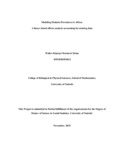| dc.description.abstract | Malaria is one of the leading causes of illness and mortality in Africa. A lot of resources have been, and continue to be channeled towards prevention, controlling and treatment of malaria. The World Health Organization receives annual data of reported malaria cases from all member countries including a number of African countries albeit some missing reports. The objective of this research is to use a statistical model to manipulate reported longitudinal data from selected African countries for the period 2000 to 2012 to estimate malaria disease burden. This model will also address the issue of missing data, which is a shortcoming in most Africa Countries. The longitudinal nature of the data will be modeled using linear mixed-effects model using country specific intercepts and slopes. These models accounts for heterogeneity between countries with regards to magnitude of malaria. The model is also robust in cases where data is incomplete. As a final step, two ways of acknowledging and accounting for missing information (complete case analysis and multiple imputations) were explored and results compared with the direct likelihood approach whereby all the observed data is used for analysis. Results indicated that the model is flexible enough to capture the variability in profiles of different countries, thus allowing for inference regarding the reported number of confirmed malaria cases for any given period per country. In conclusion, the number of reported and confirmed malaria cases in Africa between the year 2000 and 2012 highly depends on the country under investigation. Some countries reported high cases while others reported fewer cases. The evolution of the number of cases over time has remained relatively constant. Therefore, choices on which countries have a higher malaria burden can be made with certainty, thus focusing more intervention resources to those countries as it’s expected that for the lower risk countries, the rate of malaria infection will also remain relatively constantly low. Keywords: Linear mixed-effects model, malaria, multiple imputation, Africa | en_US |

